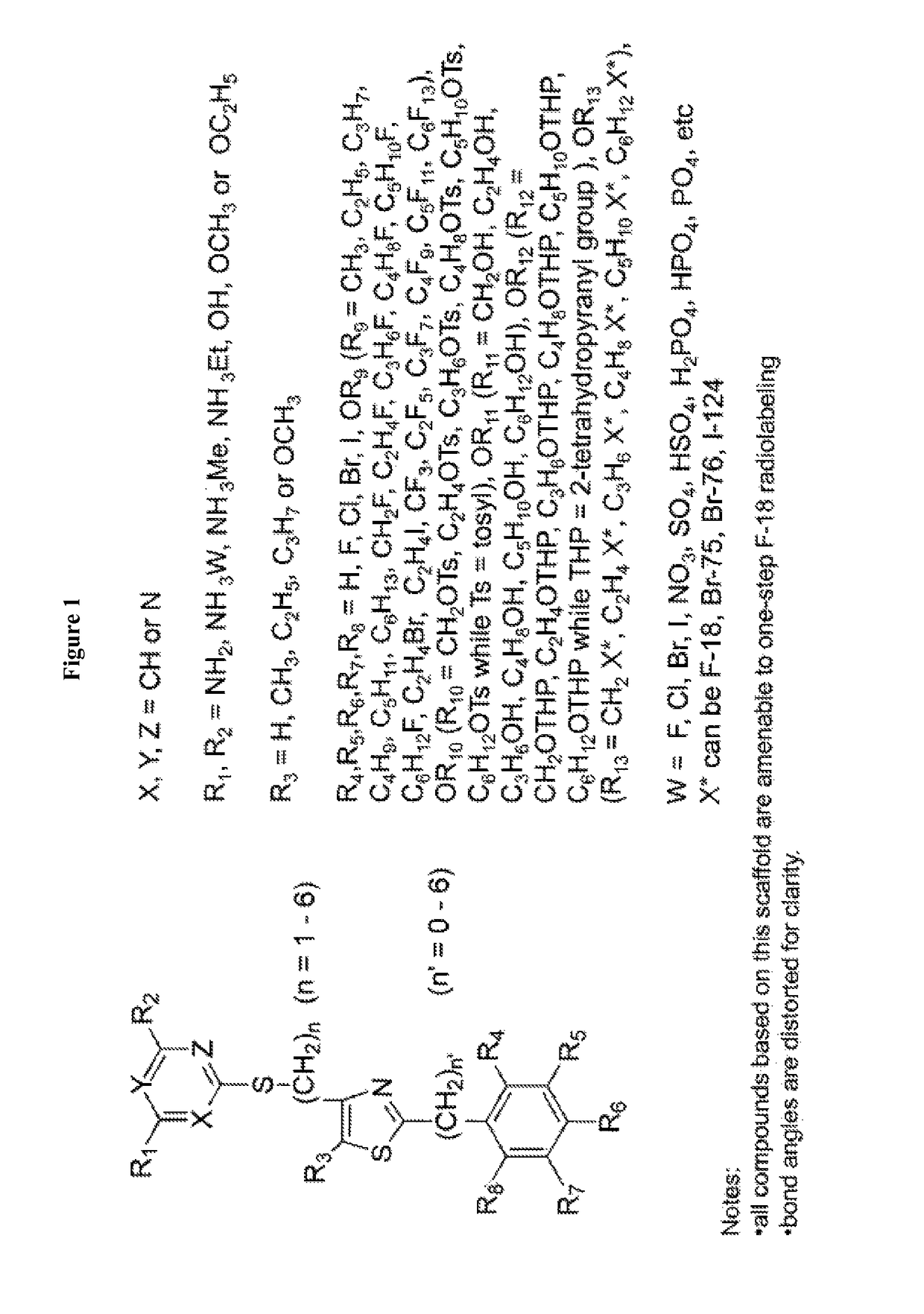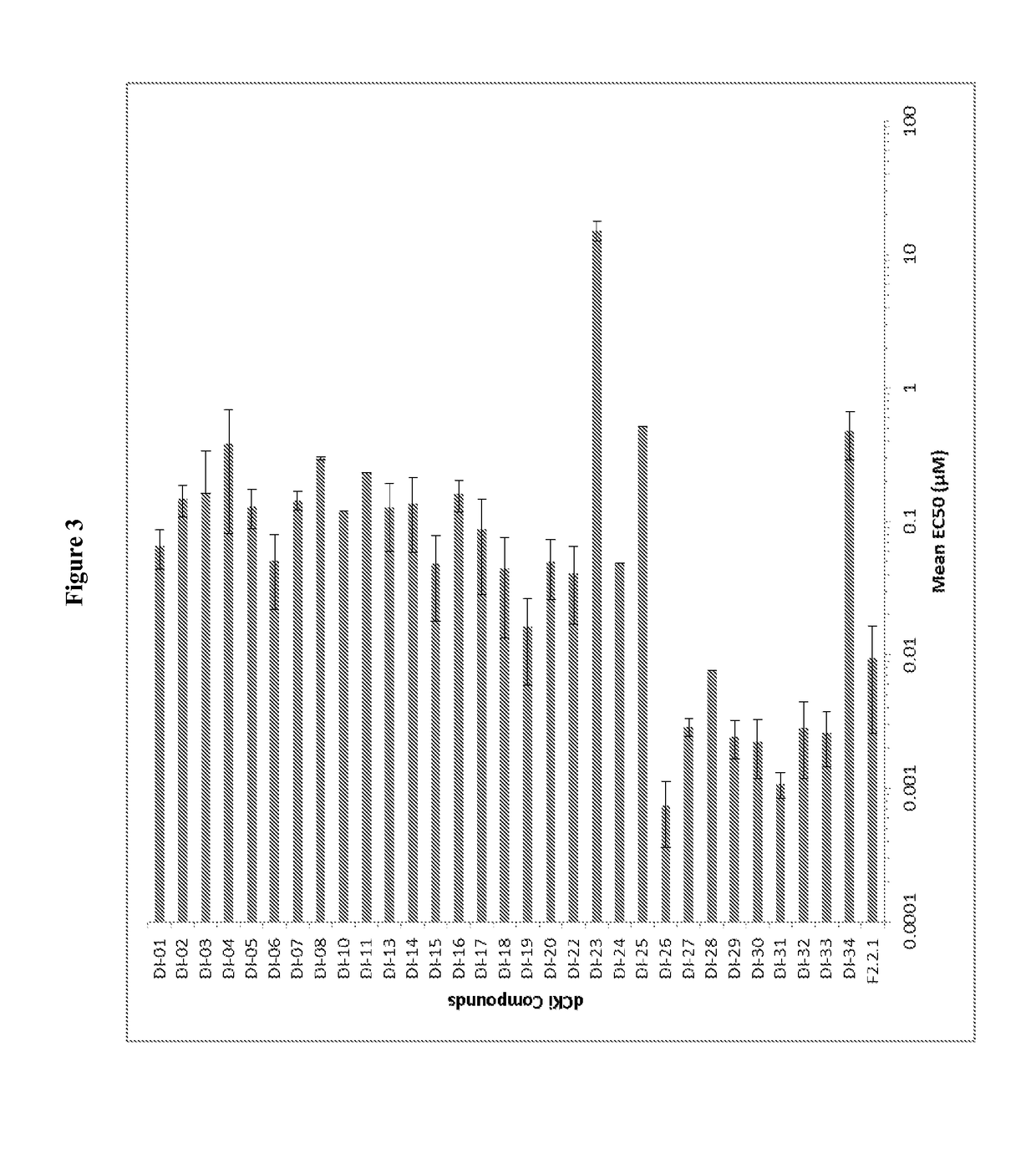Deoxycytidine kinase binding compounds
a technology of deoxycytidine and kinase, which is applied in the direction of chemical treatment enzyme inactivation, drug composition, enzymology, etc., can solve the problems of lack of specialized probes and limited pet studies of immune function
- Summary
- Abstract
- Description
- Claims
- Application Information
AI Technical Summary
Benefits of technology
Problems solved by technology
Method used
Image
Examples
example 1
Synthesis of Compound DI-F2.2.1
[0221]Compound DI-F2.2.1 was synthesized according to the following scheme:
[0222]
[0223]To a solution of functionalized benzonitrile substrate (2.0 g, 13.4 mmol) in anhydrous DMF (30 mL) at room temperature under N2, Cs2CO3 (8.74 g, 26.8 mol) and 1-bromo-2-fluoroethane (5.07 g, 40.2 mmol) were added once. The mixture was stirred at 50° C. for 2 days. The solvent was removed in vacuo and the crude material was taken on to the next step without further purification (2.14 g, 82%). Exemplary NMR data given for the synthetic intermediate towards F2.2.1: 1H NMR (CDCl3) δ: 7.31-7.34 (dd, J=1.9, 8.4 Hz, 1H), 7.13-7.13 (d, J=1.9 Hz, 1H), 6.91-6.93 (d, J=8.4 Hz, 1H), 4.85-4.87 (m, 1H), 4.73-4.75 (m, 1H), 4.30-4.32 (m, 1H), 4.23-4.25 (m, 1H), 3.93 (s, 1H).
[0224]The crude fluoroethoxy substrate (1.00 g, 5.1 mmol) was dissolved in pyridine (3.5 mL), then triethylamine (0.8 mL), and ammonium sulfide 20% wt solution in water (2.0 mL) were added into the mixture at 60°...
example 2
Synthesis of Compound DI-26
[0229]Compound DI-26 was synthesized according to the following scheme. A 1H NMR spectrum of Compound DI-16 in DMSO-d6 is shown in FIG. 3.
[0230]
[0231]Step 1: To a solution of 3-Hydroxy-4-methoxybenzonitrile (8.0 g, 53.6 mmol) in anhydrous DMF (114 mL) at room temperature under N2, Cs2CO3 (35.0 g, 107.3 mol) and (2-bromoethoxy)-tert-butyldimethylsilane (25.7 g, 107.3 mmol) were added. The mixture was heated to 50° C. and stirred for 24 hours. The DMF was removed in vacuo and the reaction mixture was extracted with ethyl acetate. The organic layer was washed three times with water, dried over anhydrous MgSO4, and concentrated in vacuo. The crude material was purified by flash column chromatography to yield a white solid (16.3 g, 99%). 1H NMR (CDCl3) δ: 7.26-7.28 (dd, J=1.9, 8.4 Hz, 1H), 7.17-7.17 (d, J=1.9 Hz, 1H), 6.87-6.89 (d, J=8.4 Hz, 1H), 4.09-4.12 (m, 2H), 3.98-4.01 (m, 2H), 3.90 (s, 3H), 0.89 (s, 9H), 0.08 (s, 6H); 13C NMR (CDCl3): 153.3, 148.7, 126.5...
example 3
Synthesis of Compound DI-30
[0236]Compound DI-30 was synthesized according to the following scheme, following the procedures similar to those described in Example 2. 1H NMR spectrum of Compound DI-30 in DMSO-d6 is shown in FIG. 24. ESI TOF MS m / z 419.1325, calculated for C18H23N6O2S2 ([M+H]+) 419.1324.
[0237]
PUM
| Property | Measurement | Unit |
|---|---|---|
| temperature | aaaaa | aaaaa |
| temperature | aaaaa | aaaaa |
| PET imaging | aaaaa | aaaaa |
Abstract
Description
Claims
Application Information
 Login to View More
Login to View More - R&D
- Intellectual Property
- Life Sciences
- Materials
- Tech Scout
- Unparalleled Data Quality
- Higher Quality Content
- 60% Fewer Hallucinations
Browse by: Latest US Patents, China's latest patents, Technical Efficacy Thesaurus, Application Domain, Technology Topic, Popular Technical Reports.
© 2025 PatSnap. All rights reserved.Legal|Privacy policy|Modern Slavery Act Transparency Statement|Sitemap|About US| Contact US: help@patsnap.com



